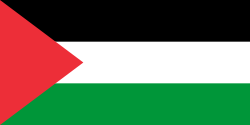Top Qs
Timeline
Chat
Perspective
Popular Forces administration in the Gaza Strip
From Wikipedia, the free encyclopedia
Remove ads
During the Gaza war, the Popular Forces, an anti-Hamas, Israeli-backed, and allegedly Islamic State-linked armed group, has claimed control over large amounts of the Gaza Strip that are currently under Israeli military occupation.[3][4] If true, this is the first area in Gaza not administrated by Hamas since 2007.[5]
More than 2,000 Palestinian civilians live in the Popular Forces' territory, according to the group's then-leader Yasser Abu Shabab.[3]
The group claims control of Al-Bayuk as its headquarters,[6][7] eastern Rafah,[3][5][2] eastern Khan Yunis,[8] and humanitarian aid routes near the Kerem Shalom border crossing.[9][10] It says it has freedom of movement in the wider Rafah area.[2] Furthermore, the Popular Army – Northern Forces, which reportedly operates as part of the Popular Forces,[11][12] has claimed control over several areas in northern Gaza.[13]
Remove ads
Background
Before the war, the land presently administrated by the Popular Forces belonged to the Tarabin Bedouin tribe, of which Yasser Abu Shabab was a member.[5]
The last attempt at a large-scale armed revolt against the Hamas government in Gaza was in 2009, when Jund Ansar Allah, a Gazan Salafi jihadist group, engaged in clashes with Hamas forces after declaring the establishment of an Islamic emirate in Gaza.
Remove ads
History
Summarize
Perspective
In Southern Gaza
In late May 2025, the Rafah Governorate came under full Israeli operational control following its successful Rafah offensive against Hamas, in which the Popular Forces participated.[14][15] As of 27 June, the group was reportedly in control of eastern Rafah, enjoyed freedom of movement in the wider Rafah area, and was working on building an independent administration.[2] By August, The Washington Post was describing the Popular Forces as "the de facto authority in southeastern Gaza".[3]
On 24 July, The Wall Street Journal published an opinion piece written by Abu Shabab, where he called on the United States and Arab countries to recognize the Popular Forces' administration. He also claimed armed patrols were providing security and that civilians in the area were enjoying a better quality of life, untouched by the humanitarian crisis elsewhere in Gaza.[5][4][16]
In November 2025, the Popular Forces voiced their support for the Gaza peace plan and their willingness to cooperate with the United Nations mandated Board of Peace established to oversee the administration and reconstruction of the Gaza Strip.[17]
Following the implementation of a ceasefire in the Gaza Strip on 10 October, the Popular Forces said that they welcomed the agreement, but would "continue to defend their lands" and had no intention of leaving the Gaza Strip.[18]
In November 2025[19], it was revealed that an allegedly Popular Forces affiliated militia led by Shawqi Abu Nasira in Eastern Khan Yunis was active.[20]
Following Yasser Abu Shabab's death, Ghassan Duhine proclaimed himself the new leader of the Popular Forces.[21]
Public services
After consolidation of Popular Forces control, Abu Shabab began launching a recruitment drive to staff “administrative and community committees,” including doctors and nurses, engineers, primary schoolteachers and public relations experts. The Popular Forces began setting up checkpoints in Israeli occupied territory to screen convoys of international aid workers entering Gaza, and claimed they were providing security to aid trucks. Abu Shabab also said that they have built schools, health centers and other civilian infrastructure, Sky News similarly reported that medical facilities, a school, and a mosque have been built by the Popular Forces.[6][3]
In Northern Gaza
On 14 October, the Popular Army – Northern Forces claimed it had taken control of several areas in northern Gaza, and warned Hamas forces against approaching their territories.[13][22] Its flag featuring the logo of PANF, is displayed on its vehicles and facilities within its territory.[23]
Remove ads
See also
- Hamas–Popular Forces conflict
- Societal breakdown in the Gaza Strip during the Gaza war
- Counter-Terrorism Strike Force
- Counter-Terrorism Strike Force administration in the Gaza Strip
- Shuja'iyya Popular Defense Forces
- Shuja'iyya Popular Defense Forces administration in the Gaza Strip
- Rival government
- Wartime collaboration
- Project New Gaza
References
External links
Wikiwand - on
Seamless Wikipedia browsing. On steroids.
Remove ads


